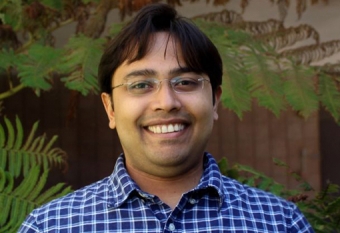
Egg and sperm are unique cells that pass on genetic information in humans and other mammals from one generation to the next. They originate from a small group of cells called primordial germ cells (PGCs) that form early in a developing embryo. Because researchers have minimal access to early post-implanted human embryos for ethical reasons, very little is known about the process by which PGCs arise in humans.
“Primordial germ cells differentiate to form either sperm or egg, but we don’t know exactly how or when these cells are first formed,” explains Siddharth Dey, an assistant professor in UC Santa Barbara’s Bioengineering and Chemical Engineering Departments. “Numerous questions still exist, like what molecular mechanisms give rise to PCGs? Why do they only emerge in a certain location of an embryo? And what influence do neighboring cells play in the process?”
To answer these and other related questions, Dey has proposed employing a new technology that uses light to track the location and movement of cells in tissues and make molecular measurements. He was recently awarded more than $1 million in funding from the National Science Foundation (NSF) to pursue this research after receiving an Early CAREER Award, which is regarded as the federal agency’s most prestigious honor for junior faculty.
“It is exciting to receive a CAREER Award,” said Dey, who joined the UCSB faculty in 2017 and completed his PhD in chemical and biomolecular engineering at UC Berkeley. “I see the recognition as a testament to their support and interest in my work, and it further motivates me to continue pursuing impactful and leading-edge research.”
Dey became the twenty-fourth UCSB assistant professor to receive the esteemed recognition since the 2017-’18 academic year. The university has consistently ranked among the top public universities in the percentage of eligible assistant professors who have received NSF Early CAREER Awards.
“Congratulations to Professor Dey on this tremendous honor,” said Umesh Mishra, dean of UCSB’s College of Engineering. “We look forward to the significant contributions that his research will continue to bring to his field and the College of Engineering, and to the insight that his innovative work will reveal about the earliest stages of human development.”
All cells within a human, such as liver cells or neurons in the brain, contain the same genome, or DNA. The variety of cell functions, such as specialized cells in the eye that detect light or immune cells that fight infections, are determined by how and when different sets of genes are turned on or off inside a cell. Chemical modifications to DNA and specific proteins that are bound to DNA, known as the epigenome, play a key role in turning genes on or off, thereby altering a cell’s gene expression or function. In his project, titled “Elucidating spatial and epigenetic regulation of gene expression during human development using photopatterning and single-cell multiomics,” Dey proposes to employ methods to better understand how the specific arrangement, or spatial organization, of individual cells within a human tissue impacts its gene expression. For example, researchers have found differences in gene activity based on where a cell is in a tissue, demonstrating how a cell’s location and environment in a cancerous tumor can strongly influence which genes are active and the cell’s function within the tissue.
“The advantage of knowing where a cell is located within a tissue is that it provides a point of reference that can be integrated with measurements taken over the entire human genome, which includes nearly 20,000 genes,” he said.
Genome-wide measurements can be taken on a wide variety of molecules, including messenger ribonucleic acids (mRNAs) and epigenetic modifications, which will allow Dey to quantify what is happening with all genes and provide a more comprehensive view of the biological system.
“We will have the spatial context to determine a cell’s neighboring cells, and the interactions and environment to which it might be exposed. This will be invaluable, especially when it comes to PCGs,” said Dey.
NSF funding will allow Dey to enhance a novel technology that he and Max Wilson, an assistant professor in UCSB’s Molecular, Cellular, and Developmental Biology Department, recently developed to provide spatial information of cells. They designed synthetic DNA molecules, called photo-sensitive oligonucleotides (PSOs), which are responsive to light. The PSOs are embedded into cell membranes, which are then exposed to varying degrees of ultraviolet light, meaning cells in one area of the sample would receive a lot of UV light, while others in a different location would receive less or none at all. The light pattern allows them to “stamp” the position of each cell.
“Once we detach the tissue and sequence individual cells, we can also sequence the synthetic molecule,” he explained. “Depending on the extent of cleavage that we detect, we can infer the light intensity a particular cell was exposed to, thereby allowing us to predict its position in a tissue based on the spatial patterning of light that was applied."
Dey says that this new technology overcomes several shortfalls of existing technologies, which are limited by their resolution and ability to comprehensively sequence different kinds of molecules in a single cell. Present-day technology generally also allows only spatial sequencing from fixed cells, where the cellular structures are frozen at a single point in time and do not move. The new technology makes it possible to sequence live cells, which could allow scientists to study how cells move and change over time.
“In addition to improving the resolution of our technology, this funding will allow us to extend our method to live cells. Being able to apply this method to live cells is key because it will enable us to track cell migration and tissue morphogenesis that are linked to the emergence of distinct cellular characteristics,” said Dey.
Early data also showed that each additional PSO embedded within a cell increased the accuracy with which they could assign the spatial location of individual cells. When six PSOs were added to a cell, they had 90-percent accuracy.
“Once we refine our technologies, we can begin to examine how spatial environments, cell-to-cell contact, long-range signaling, and the epigenome drive primordial germ cells specification,” said Dey. “We hope to be able to answer some important questions with two- or three-dimensional in vitro systems, where we can mimic embryogenesis with embryo-like structures in a dish.”
The successful development and deployment of this technology would provide key opportunities for researchers to understand how cell identity is altered in various applications, ranging from developmental biology to cancers and aging. For example, knowledge of how human PGCs develop, says Dey, could help scientists answer questions about infertility, which according to the World Health Organization (WHO), affects 9 percent of men and 11 percent of women of childbearing age in the U.S.



